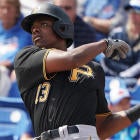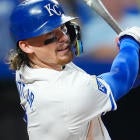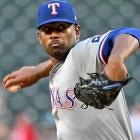
The line between sleepers and breakouts is a thin one. I've already released my Sleepers 2.0, and in it, I mentioned that my favorite bargain picks would probably be in Breakouts 2.0. I'll echo that sentiment here: Of all the lists I make consisting of players I like, this one has the highest concentration of players I actually draft.
So what's the distinction between sleepers and breakouts? Well, a breakout is someone who has the potential to reach a previously unreached height while a sleeper could be a player that's undervalued for any reason. Still, because most are sleepers are also breakouts, the ones I tend to feature here are the ones whose unreached heights are especially high.
They're not just nice buys. They're the kind that could decide your entire season.
Zach Plesac, SP, Indians
| ||||||||||||
Plesac has gone from relative nobody to a fairly high draft pick in the span of the eight starts he made last year, so you might argue the breakout already happened. But seeing as he was the No. 3 starting pitcher in Head-to-Head points per game last year, ranking behind only Cy Young winners Shane Bieber and Trevor Bauer, drafting him among the top 25 starting pitchers still doesn't take full account of his upside.
Last year, he made the simple change that has brought out the best in so many of his contemporaries. He emphasized his best pitches, throwing his not-so-special fastball about one-third of the time instead of half. His slider and changeup, both already superior pitches, became even more effective, each generating whiffs at an elite rate, and yet even with his reliance on secondary pitches, he dominated the strike zone, ranking eight in strike percentage and third in walks per nine. Most significant is what that efficiency meant for his workload. Not a single starting pitcher went seven-plus as consistently as Plesac did last year, and not one of his eight starts went less than six innings. For starting pitchers in today's MLB, working deep is half the battle.
Sure, an eight-start sample isn't enough to determine anything conclusive about Plesac, but the bottom line is that the number of starting pitchers who will genuinely matter in Fantasy Baseball is finite. It takes skills, and it takes volume. And in Plesac's case, if the skills are even enough for him to live up to his 3.38 xERA or 3.50 xFIP, much less the 2.28 ERA, then we already have evidence he'll get the volume he needs for those skills to matter.
Nick Castellanos, OF, Reds
| ||||||||||||
Last year, I became so enamored with Castellanos' potential in Cincinnati's ballpark that I began comparing him to early-round mainstays like Nolan Arenado and J.D. Martinez. Won't you join me in doubling down?
Sure, it seems like it was woefully misguided at first glance, but a second glance will show you that he deserved much better than he got, with Statcast putting his expected batting average at .273 and expecting slugging percentage at .542. And that was with a career-worst strikeout rate that's easy enough to attribute to the small sample size. More than anything, though, it's Castellanos' .257 BABIP in spite of his typically elite line-drive rate that suggests he was a hard-luck case all the way around. He's about where Marcell Ozuna was at this time last year in terms of expected results vs. actual results, and a comparable course correction would be unsurprising.
Will Smith, C, Dodgers
| ||||||||||||
The read on Smith at this time a year ago was a three-true-outcomes hitter who might not hit for enough average to warrant everyday at-bats, so when the Dodgers began fading him early 2020, it seemed like they had made their assessment known. But in part-time duty, that prickly caterpillar of a profile became a breathtaking butterfly, Smith's strikeout rate going from one end of the spectrum (26.5 percent) to the other (16.1 percent). That's like the difference between Pete Alonso and Whit Merrifield. He no longer sold out so hard for power, giving him a sturdier BABIP base, and his walk rate blew up, too. And seeing as he started all but one of the team's postseason games, the Dodgers may be done fading him.
James Karinchak, RP, Indians
| ||||||||||||
Karinchak is one of those breakout picks that risks being too obvious since most everyone sees the 17.7 K/9 (tied with Devin Williams for tops among relievers last year) and recognizes that Brand Hand is now out of the picture for Cleveland. But when it comes to actually drafting him, there's some hesitance that I think creates real opportunity.
Yes, Terry Francona hasn't officially given him the job yet, but few on the Indians beat are treating it as a true competition, instead, they're calling Karinchak a "heavy favorite" while listing off a few token alternatives. And seeing as Karinchak was long rumored to be the reason the Indians might move on from Hand, what would stop him from claiming the ninth-inning role now? The walk rate? It's true that 5.3 per nine innings is high, but when he's striking out half the batters he faces, the math changes for everything else. Teams don't score on walks alone.
And make no mistake, Karinchak's bat-missing is historic, positioning him as of the few relievers, much like Josh Hader, who'll hang with certain starting pitchers in the strikeout category. For crying out loud, he had more strikeouts than Max Fried last year. That kind of upside warrants a glass-half-full approach.
Lance McCullers, SP, Astros
| ||||||||||||
McCullers has long stood out for both his ground-ball rate (which would have ranked second among qualifiers last year, behind only teammate Framber Valdez), and his potential to strike out 10 batters per nine innings. Pitchers who excel at both are rare, and McCullers' ratios, in particular, would suggest a Luis Castillo-like outcome is possible.
His biggest issue is that he hasn't held together long enough, having yet to throw even 130 innings in a major-league season despite debuting in 2015. He'll be in good company if he reaches that modest total this year, though, given how careful organizations figure to be with their most coveted hurlers after a shortened 2020, and it's still possible McCullers blows away his previous high now that his 2018 Tommy John surgery is fully behind him.
By the way, he wasn't quite himself early last year, coming off the procedure. The curveball that he normally lives and dies with, featuring it about 50 percent of the time, didn't get that same usage early on. Only in his final three starts did McCullers throw it so prominently, and how did those go? He had a 0.00 ERA, 0.62 WHIP and 12.2 K/9.
Joe Musgrove, SP, Padres
| ||||||||||||
After going 106 appearances without a double digit-strikeout effort, Musgrove had two to end 2020. It goes to show you what kind of heights he was reaching to end last season when he regained the velocity on his fastball after some early triceps issues and started playing his slider off his curveball in a way he never had before. His 14.4 percent swinging-strike rate would have ranked among the top 10 qualifiers, alongside Yu Darvish, and his 3.19 xFIP was better than Trevor Bauer's. Musgrove has historically been an elite strike-thrower, allowing him to pitch six and seven innings with ease, and now with San Diego, he has the supporting cast to make it hold up.
Kevin Gausman, SP, Giants
| ||||||||||||
Gausman is no stranger to breakout lists, least of all mine, but last year, right about the point when everyone had given up on him, the 30-year-old showed his clearest signs of a breakout yet, going from never striking out even a batter per inning to having nearly 12 strikeouts per nine. That rate would have ranked eighth among qualifiers, just ahead of Gerrit Cole, and had the swinging-strike rate to match, ranking just behind Cole at 15.2 percent. Gausman's splitter has always been an elite swing-and-miss pitch, and by leaning on it more, his fastball began playing up, too.
It's worth pointing out he had just one double digit-strikeout effort in 2020, getting built up slower because of a balky elbow, but he began throwing six innings with consistency in September and made such believers of the Giants that they extended him a qualifying offer (which he accepted for $18.9 million). The usual sample size caveats of course apply, particularly for someone with Gausman's uninspiring track record, but since he only requires a mid-round investment, it's another case of the reward far outweighing the risk.
Ke'Bryan Hayes, 3B, Pirates
| ||||||||||||
I've had a hunch with Hayes for a while now that he might ultimately go the Francisco Lindor route. Both failed to deliver numbers befitting their prospect standing in the minors but generally put the bat on the ball, met a certain athletic standard best exhibited through their defense, and retained glowing scouting reports throughout their ups and downs. Any prospect has a chance of taking another step forward upon reaching the majors, but the ones like Lindor and Hayes who have already cleared the biggest hurdle for maximizing raw ability -- i.e., putting the bat on the ball -- seem especially poised to do so.
The Braves' Cristian Pache also fits the bill, for what it's worth, but for now, let's stick with Hayes, who showed the earliest signs of it last September with elite exit velocities and more over-the-fence power than he ever showed in the minors. His high contact rate and all-fields approach should make him a cinch for batting average, and he's athletic enough to swipe 12-15 bags as well. If he comes closer to 30 homers than 20, which seems all the more possible given his 2020 debut, we're talking about a guy who gets drafted in the first four rounds next year.
Clint Frazier, OF, Yankees
| ||||||||||||
As with Karinchak, the hesitance with Frazier seems to have more to do with his role than his actual performance, but manager Aaron Boone has reiterated, both before and after the Yankees brought back Brett Gardner, that Frazier will retain the starting left field job he claimed early on last year. And well, why wouldn't he? Having finally put the 2018 concussion behind him and after making some tweaks his batting stance that helped him recapture what GM Brian Cashman once described as "legendary" bat speed, Frazier finally made good on his prospect hype last year, averaging about as many Head-to-Head points per game as Michael Conforto.
The power wasn't as surprising as the plate discipline, but since the climbing walk was evident as early as last spring, I'm not so quick to dismiss Frazier's .394 on-base percentage. If he contributes something like it along with 30 homers and 10 steals, you'll get well more than you paid for.
Tyler Mahle, SP, Reds
| ||||||||||||
Over the course of his minor-league career, Mahle was able to dominate to the tune of a 2.87 ERA on the strength of his fastball alone, and it made him effective for stretches during his first three years in the majors as well. But due to his overreliance on that one pitch, he was pretty much toast the third time through a lineup and, thus, difficult to trust as a traditional starting pitcher.
That all changed last year when he unveiled a slider that functioned as a swing-and-pitch in its own right. Classified as a cutter on some tracking systems because of the way it moves, it served as such an effective counter to his fastball that its effectiveness shot way up, too, resulting in a K/9 rate (11.3) and a swinging-strike rate (13.8 percent) that ranked among the elites. And perhaps most revealing, the hitters Mahle faced a third time through the order went only 2 for 31 against him. That's compared to 34 for 97 (.351) with a 1.004 OPS in 2019, and it makes him someone the Reds can trust to leave out there six or seven innings at a time.
Nick Madrigal, 2B, White Sox
| ||||||||||||
Second base is arguably the weakest position, stolen bases the scarcest contribution and batting average the most difficult category to bolster late. Madrigal, a player going outside the top 200 on average, could be a significant contributor to all three. He's so uniquely suited to meet so meet scarcities that his late-round availability is almost too good to be true. And seeing as he's a consensus top prospect with a starting job all but locked up already, it doesn't make much sense either.
Now look, he's a virtual zero for home runs, and at a time when everybody who's anybody has the capacity for 20 or more, it puts a clear limit on his upside. It's also possible that some people are waiting to see how he rebounds from an October shoulder surgery, but for a non-power hitter, any concerns in that area are probably overblown. There's certainly no doubting Madrigal's contact skills. He struck out 21 times in 707 minor-league plate appearances, which makes his 6.4 percent major-league rate look like he's swinging from his heels, and while the steals potential hasn't fully revealed itself yet, he stole 35 bases in his latest minor-league season.
John Means, SP, Orioles
| ||||||||||||
Means' spike in velocity (about 2 mph) was there from the start of 2020 but easy enough to overlook when it didn't make for better results. That all changed after six starts, though, when his swinging-strike rate jumped from its typically uninspiring 8.7 percent to a Gerrit Cole-like 15.7 percent for his final four starts. What it meant for his forward-facing numbers was just as notable: His K/9 went from 5.4 to 11.4 and his ERA from 8.10 to 1.52.
Maybe it was just a weird blip to end a weird season, or maybe it was the logical next step for a pitcher who saw one of the biggest improvements in pure stuff and already had a mastery of the strike zone, issuing no more than one walk in any of his 10 starts.








































